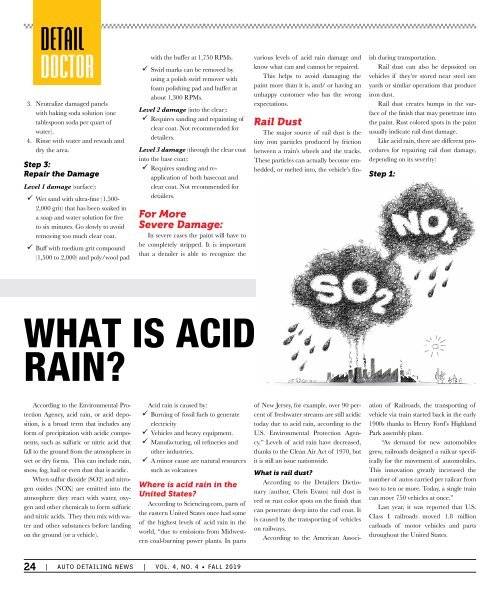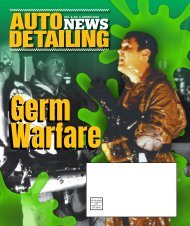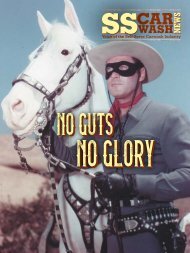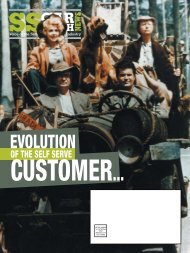You also want an ePaper? Increase the reach of your titles
YUMPU automatically turns print PDFs into web optimized ePapers that Google loves.
DETAIL<br />
DOCTOR<br />
3. Neutralize damaged panels<br />
with baking soda solution (one<br />
tablespoon soda per quart of<br />
water).<br />
4. Rinse with water and rewash and<br />
dry the area.<br />
Step 3:<br />
Repair the Damage<br />
Level 1 damage (surface):<br />
Wet sand with ultra-fine (1,500-<br />
2,000 grit) that has been soaked in<br />
a soap and water solution for five<br />
to six minutes. Go slowly to avoid<br />
removing too much clear coat.<br />
Buff with medium grit compound<br />
(1,500 to 2,000) and poly/wool pad<br />
with the buffer at 1,750 RPMs.<br />
Swirl marks can be removed by<br />
using a polish swirl remover with<br />
foam polishing pad and buffer at<br />
about 1,300 RPMs.<br />
Level 2 damage (into the clear):<br />
Requires sanding and repainting of<br />
clear coat. Not recommended for<br />
detailers.<br />
Level 3 damage (through the clear coat<br />
into the base coat):<br />
Requires sanding and reapplication<br />
of both basecoat and<br />
clear coat. Not recommended for<br />
detailers.<br />
For More<br />
Severe Damage:<br />
In severe cases the paint will have to<br />
be completely stripped. It is important<br />
that a detailer is able to recognize the<br />
various levels of acid rain damage and<br />
know what can and cannot be repaired.<br />
This helps to avoid damaging the<br />
paint more than it is, and/ or having an<br />
unhappy customer who has the wrong<br />
expectations.<br />
Rail Dust<br />
The major source of rail dust is the<br />
tiny iron particles produced by friction<br />
between a train’s wheels and the tracks.<br />
These particles can actually become embedded,<br />
or melted into, the vehicle’s finish<br />
during transportation.<br />
Rail dust can also be deposited on<br />
vehicles if they’re stored near steel ore<br />
yards or similar operations that produce<br />
iron dust.<br />
Rail dust creates bumps in the surface<br />
of the finish that may penetrate into<br />
the paint. Rust colored spots in the paint<br />
usually indicate rail dust damage.<br />
Like acid rain, there are different procedures<br />
for repairing rail dust damage,<br />
depending on its severity:<br />
Step 1:<br />
WHAT IS ACID<br />
RAIN?<br />
According to the Environmental Protection<br />
Agency, acid rain, or acid deposition,<br />
is a broad term that includes any<br />
form of precipitation with acidic components,<br />
such as sulfuric or nitric acid that<br />
fall to the ground from the atmosphere in<br />
wet or dry forms. This can include rain,<br />
snow, fog, hail or even dust that is acidic.<br />
When sulfur dioxide (SO2) and nitrogen<br />
oxides (NOX) are emitted into the<br />
atmosphere they react with water, oxygen<br />
and other chemicals to form sulfuric<br />
and nitric acids. They then mix with water<br />
and other substances before landing<br />
on the ground (or a vehicle).<br />
Acid rain is caused by:<br />
Burning of fossil fuels to generate<br />
electricity<br />
Vehicles and heavy equipment.<br />
Manufacturing, oil refineries and<br />
other industries.<br />
A minor cause are natural resources<br />
such as volcanoes<br />
Where is acid rain in the<br />
United States?<br />
According to Sciencing.com, parts of<br />
the eastern United States once had some<br />
of the highest levels of acid rain in the<br />
world, “due to emissions from Midwestern<br />
coal-burning power plants. In parts<br />
of New Jersey, for example, over 90 percent<br />
of freshwater streams are still acidic<br />
today due to acid rain, according to the<br />
U.S. Environmental Protection Agency.”<br />
Levels of acid rain have decreased,<br />
thanks to the Clean Air Act of 1970, but<br />
it is still an issue nationwide.<br />
What is rail dust?<br />
According to the Detailers Dictionary<br />
(author, Chris Evans) rail dust is<br />
red or rust color spots on the finish that<br />
can penetrate deep into the carl coat. It<br />
is caused by the transporting of vehicles<br />
on railways.<br />
According to the American Association<br />
of Railroads, the transporting of<br />
vehicle via train started back in the early<br />
1900s thanks to Henry Ford’s Highland<br />
Park assembly plant.<br />
“As demand for new automobiles<br />
grew, railroads designed a railcar specifically<br />
for the movement of automobiles.<br />
This innovation greatly increased the<br />
number of autos carried per railcar from<br />
two to ten or more. Today, a single train<br />
can move 750 vehicles at once.”<br />
Last year, it was reported that U.S.<br />
Class I railroads moved 1.8 million<br />
carloads of motor vehicles and parts<br />
throughout the United States.<br />
24 | AUTO DETAILING NEWS | VOL. 4, NO. 4 • FALL <strong>2019</strong>

















